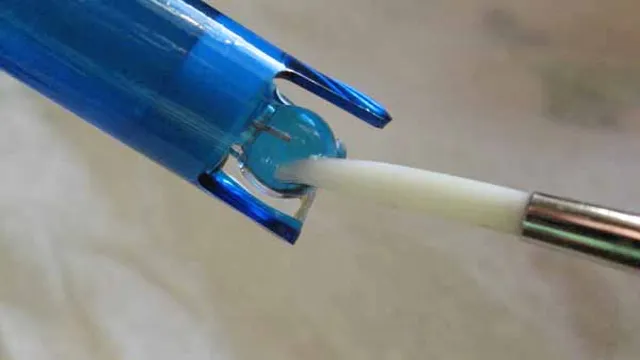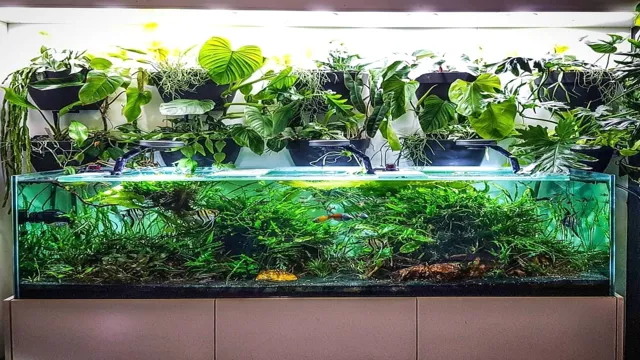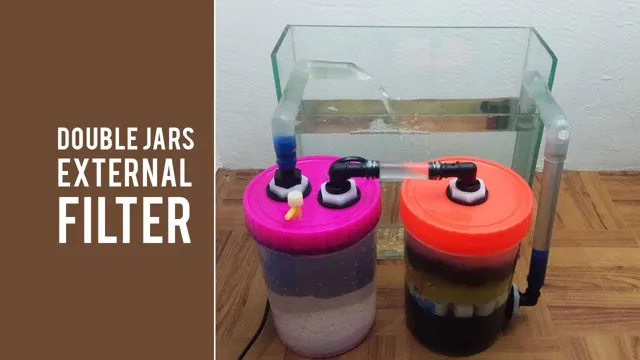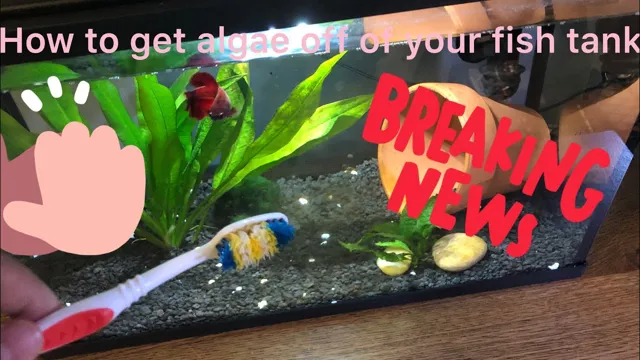Do you want to add a touch of nature to your aquarium? One way to achieve this is by growing live plants in your tank. These plants provide numerous benefits to your aquatic pets, including oxygen production and increased water quality. Not only that, they also create a beautiful and natural underwater environment that is calming and pleasing to the eye.
There are several types of aquatic plants that you can choose from to grow in your aquarium. Some popular options include Java Fern, Anubias, and Cryptocoryne. These plants are relatively easy to care for and do not require special lighting or equipment to thrive.
Growing live plants in your aquarium can also be a fun and rewarding hobby. Watching your plants grow and flourish can be a satisfying experience. It can also provide an opportunity for you to learn about the different types of plants and their individual needs.
However, it is important to note that proper care and maintenance is necessary to ensure your plants survive in your tank. Factors such as lighting, water temperature, and water quality all play a crucial role in the growth and health of your plants. Overall, adding live plants to your aquarium is a great way to improve the overall health and aesthetics of your underwater world.
With a little bit of research and effort, you can reap the numerous benefits of growing live plants in your tank.
Benefits of Live Plants in an Aquarium
If you are looking to create a vibrant and lively aquarium, growing live plants can add an abundance of benefits to both your fish and the overall aesthetic. Not only do live plants enhance the natural environment, but they also release oxygen and remove harmful toxins, creating a healthier and more balanced ecosystem for your aquatic creatures. To grow live plants in your aquarium, you’ll need to provide the right lighting, substrate, and nutrients in order to support their growth.
One popular method is to use LED lights specifically designed for plants and fertilize the substrate with CO With proper care and attention, your underwater garden can thrive and bring a beautiful and healthy addition to your home. So why not add some green to your aquarium and watch your fish flourish in a natural and vibrant environment?
Adding Aesthetic Value
Adding live plants to your aquarium not only adds aesthetic value but also provides numerous benefits to the aquatic life inhabiting the tank. Live plants act as a natural filtration system by absorbing waste products that are harmful to fish and other aquatic creatures. They also offer a natural source of food and shelter for certain fish species.
Additionally, live plants increase oxygen levels and reduce carbon dioxide levels in the water, creating a healthier and more balanced environment for your aquatic pets. Not to mention, they add natural beauty to your aquarium, transforming it from a stagnant water bowl into a living, breathing ecosystem. So, consider adding live plants to your aquarium and see the benefits for yourself!
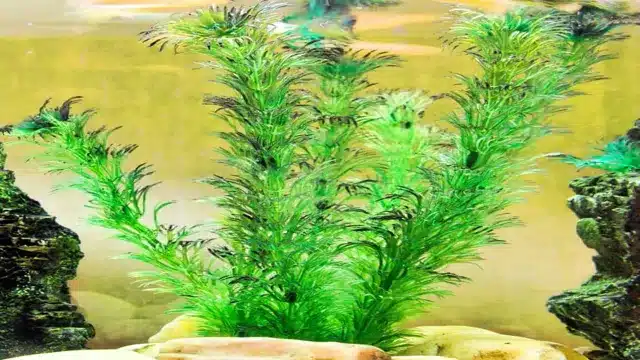
Providing Oxygen
Live plants in an aquarium provide several benefits, one of which is the provision of oxygen. They absorb carbon dioxide and release oxygen into the water, making it healthy for fish. In essence, plants and fish have a symbiotic relationship – the plants benefit from the waste produced by the fish (as nutrients), while the fish benefit from the oxygen produced by the plants.
Live plants in an aquarium also help to reduce the amount of harmful nitrates in the water by providing a natural filtration system. Plus, they enhance the overall aesthetic appeal of the aquarium, making it a more enjoyable sight to behold. Adding live plants to an aquarium is a simple way to create a healthier ecosystem for your aquatic pets.
Whether you have a small aquarium or a large one, incorporating live plants is a must for optimal health and aesthetics. So, what are you waiting for? Get your hands on some live plants and transform your aquarium into a vibrant and thriving environment for your fish!
Absorbing Nitrates and Nitrites
Live Plants in Aquariums One of the many benefits of keeping live plants in your aquarium is their ability to absorb nitrates and nitrites. Nitrates and nitrites can be harmful to fish, leading to health problems and even death in extreme cases. However, live plants have the ability to naturally absorb these elements and use them as nutrients for growth.
This not only helps to keep your aquarium clean and healthy for your fish, but can also help to reduce the amount of work you need to do to maintain your aquarium. Plus, live plants add a beautiful and natural element to your aquarium, giving your fish a more natural environment to live in. While there are other methods for reducing nitrates and nitrites, such as water changes and filtration systems, incorporating live plants into your aquarium is a natural and effective way to keep your fish happy and healthy.
So if you’re looking to create a beautiful and healthy environment for your fish, consider adding some live plants to your aquarium today.
Choosing the Right Plants
When it comes to growing live plants in your aquarium, choosing the right plants is crucial for the success of your endeavor. There are a variety of factors to consider when selecting plants, including lighting, water parameters, and the size of your tank. Some popular options for beginners include Java Fern, Java Moss, and Anubias, which are all easy to maintain and can tolerate a range of water conditions.
It’s important to also consider the growth rate of the plants you choose, as some can quickly overtake your tank if not managed properly. Ultimately, the key is to do your research and choose plants that will thrive in your specific aquarium environment. By selecting the right plants, you can create a beautiful and thriving underwater ecosystem that your fish will love, while also promoting a healthy environment for your aquatic pets.
So why not dive in and start exploring the wonderful world of live plants for your aquarium today?
Consider Lighting and CO2 Levels
When choosing the right plants for your indoor space, it’s important to consider the lighting and CO2 levels in the room. Low light or high CO2 levels can negatively impact plant health and growth, so it’s essential to choose plants that are adaptable to your specific environment. Some plants, like snake plants and peace lilies, can thrive in low light conditions and don’t require as much CO2 as other species. (See Also: How to Kill Freshwater Snails in Aquarium: Effective Methods to Eradicate the Pesky Invertebrates)
On the other hand, plants like spider plants and English ivy can help to remove toxins from the air, making them a great choice for rooms with higher CO2 levels. When selecting your plants, be sure to read up on their specific needs and requirements to ensure they will thrive in your space. By doing so, you’ll be able to create an indoor oasis that is not only visually appealing but also healthy for both you and your plants.
Research the Needs of Each Plant
When it comes to choosing the right plants for your garden, it’s important to do your research and understand the specific needs of each plant. Different plants thrive in different conditions, so you need to choose ones that are suitable for the climate and soil in your area. For example, some plants prefer full sun, while others require shade.
It’s also important to consider the amount of water the plants need and whether they prefer well-draining soil or soil that retains moisture. By understanding the needs of each plant, you can create an environment that will allow them to flourish. Don’t be afraid to experiment with different types of plants and see what works best in your garden.
By doing so, you can create a beautiful and thriving space that you can enjoy for years to come.
Consider Your Aquarium’s Size and Layout
When choosing plants for your aquarium, it’s important to consider the size and layout of your tank. For smaller tanks, you’ll want to choose plants that don’t grow too large and won’t overcrowd the space. Some great options for smaller tanks include anubias, java fern, and mosses.
For larger tanks, you’ll have more room to work with and can choose larger plants that will make a real statement. Some popular options for larger tanks include amazon swords, vals, and crypts. You’ll also want to consider the placement of your plants within your tank to ensure that your fish have plenty of swimming room and that the plants are getting adequate light and nutrients.
Remember, a well-planned plant selection won’t just make your aquarium look great, it’ll also contribute to a healthy ecosystem for your fish to thrive in.
Preparing the Aquarium
Are you ready to add some color and life to your aquarium with live plants? Before doing so, it’s important to properly prepare the tank. Start by thoroughly cleaning the aquarium and removing any decorations that may interfere with the plants’ growth. Next, add a substrate layer, which provides the plants with nutrients and helps anchor them in place.
Consider using a nutrient-rich substrate specifically designed for aquatic plants. After adding the substrate, it’s time to add the plants! Make sure to choose plants that are compatible with your aquarium’s lighting and water parameters. An important factor to keep in mind is the amount of light your plants will need to thrive.
Consider adding a light fixture that will provide the necessary light spectrum for your plants. With these preparations, your live plants will have the best chance of growing and thriving in your aquarium.
Clean the Tank and Substrate Thoroughly
Before introducing any aquatic life to the aquarium, it is important to thoroughly prepare it. This involves cleaning the tank and substrate to ensure the environment is safe and healthy for its future inhabitants. Start by emptying the tank completely and removing any decorations or equipment.
Using a scraper or sponge, remove any debris or algae buildup on the walls of the tank. Next, rinse the substrate thoroughly to remove any dust or debris. It’s important to ensure the substrate is clean as it serves as the foundation for the aquarium.
Once the tank and substrate are cleaned, fill the tank with water and add in any necessary equipment such as a filter or heater. By taking the time to properly prepare the aquarium, you are creating a healthy environment for your aquatic pets to thrive in.
Add Necessary Nutrients and Fertilizers
When preparing an aquarium, it’s important to add necessary nutrients and fertilizers to ensure a healthy aquatic environment for your fish and plants. Nutrients are essential for plant growth and formation of chlorophyll, so it’s important to have a good source of them in your aquarium. Organic fertilizers like fish waste and decaying plants can provide natural sources of nutrients, but you may also need to supplement with commercial fertilizers to meet specific plant needs.
It’s important to use fertilizers and nutrients in moderation since excess can lead to algae growth and other issues. Additionally, for a balanced aquarium, consider adding beneficial bacteria that help break down waste and maintain water quality. By providing your aquarium with the right nutrients and fertilizers, you can help your fish and plants thrive.
Planting Your Live Plants
If you’re building an aquarium, you might want to add some live plants to make it feel more natural and calming. But how do you make sure your plants will thrive in your aquatic environment? It’s essential to choose the right kind of plants and ensure they have proper lighting, substrate, and nutrients. You’ll also need to consider any fish or other aquatic creatures that may nibble on your plants.
To get started, research the best types of live plants for your aquarium, such as java ferns, anubias, or dwarf hairgrass. Make sure to provide the right lighting and substrate for their growth, and add any necessary fertilizers or supplements to ensure they have the nutrients they need. Keep an eye on your plants’ growth and make adjustments as necessary to ensure their health and longevity.
With a bit of care and attention, you can create a beautiful aquarium environment with thriving live plants. (See Also: How to Make a Planted Aquarium Step by Step: A Comprehensive Guide for Beginners)
Plant in Groups and Clusters
When it comes to planting live plants, it’s important to consider the arrangement of your garden. One tactic that can make a big impact in your garden’s overall appearance is to plant in groups and clusters. This means planting several of the same types of plants in close proximity to each other, rather than spacing them out individually.
Not only does it create a more visually appealing setting, but it also helps the plants thrive by creating a more natural environment for them to grow in. Think about how plants grow in the wild – they often grow in groups and clusters naturally. By mimicking this in your garden, you’re able to give your live plants the best possible chance of survival.
So next time you’re out in the yard planning your garden, consider grouping your live plants together to create a beautiful and thriving landscape.
Ensure Roots are Firmly Planted
To ensure that your live plants thrive, it’s essential to plant them correctly by ensuring that their roots are firmly planted. One of the first things to consider is the type of soil that you’re using. It’s important to choose a soil that is nutrient-rich, well-draining and provides good aeration.
When planting, dig a hole that is just deep enough for the root ball and wide enough to accommodate it. Gently remove the plant from its container, carefully loosening any tangled roots, and place it in the hole. Cover the roots with soil, making sure that the plant is level with the ground.
Firmly press the soil around the plant to eliminate any air pockets. Water the plant thoroughly, making sure that the water reaches the roots. To help the roots establish, consider using a root stimulator or fertilizer designed for new plants.
By following these simple steps, you can help ensure that your live plants will grow healthy and strong.
Trim Back Overgrowth
When it comes to planting live plants in your garden, the key is to trim back overgrowth. Overgrown plants can pose a risk to the health of your garden, as well as cause damage to your property. Before planting live plants, it is important to assess the growth potential of the plants, and determine how frequently they need to be trimmed back.
Trimming back overgrowth will not only keep your garden tidy, but also allow the plants to thrive and grow to their full potential. It can be tempting to let your plants grow wild and free, but this can actually do more harm than good. By regularly pruning your plants, you can ensure that they remain healthy and vibrant for years to come.
So if you want to keep your garden looking its best, make sure to trim back overgrowth and keep your plants in check!
Maintaining Your Live Plants
If you’re looking to add a touch of nature to your fish tank, consider incorporating live plants. Not only do they enhance the aesthetic appeal of your aquarium, but they also provide numerous benefits for your aquatic pets. To grow live plants in your aquarium, you’ll need to provide them with adequate lighting, substrate, and nutrients.
Consider investing in a quality aquarium light that promotes photosynthesis in plants. Moreover, choose the right substrate that allows for the proper anchoring and growth of plants. Lastly, provide your plants with essential nutrients by introducing fertilizer capsules or liquid supplements.
Remember to trim your plants regularly as needed to maintain their health and prevent overgrowth. Adding live plants to your aquarium will not only improve the appearance of your aquarium but also provide your fish with a natural environment that supports their overall well-being.
Monitor Lighting and CO2 Levels
Maintaining live plants in an aquarium takes more than just keeping the water clean and balanced. You need to ensure that the lighting conditions are just right, and the CO2 levels are adequate. Monitoring the lighting is important because plants need a certain amount of light to survive.
If there’s not enough light, the plants won’t be able to perform photosynthesis and grow. But, too much light can be just as bad, causing the plants to burn or become stressed. Additionally, it’s important to keep an eye on the CO2 levels in your aquarium.
Plants need carbon dioxide to grow, but if the levels are too high or too low, it can be harmful to the fish and other creatures in the tank. You can install a CO2 injection system to help regulate these levels and ensure that your plants are healthy and thriving. By paying close attention to these factors, you can create a beautiful and healthy aquatic environment for both your plants and your fish to thrive in.
Keep Aquarium Water Clean
Maintaining live plants in your aquarium not only adds aesthetic value but also has many benefits for the health of your fish. Live plants help in oxygenation and filtrations, and they also absorb excess nutrients that can cause algae growth. However, to keep your aquarium water clean, you need to maintain and care for the live plants regularly.
Pruning dead leaves, removing decaying matter, and changing the water regularly are essential tasks that ensure that your plants stay healthy and free from diseases. Besides, you can add plant fertilizer or CO2 supplements (if necessary) to boost plant growth and overall health. By properly maintaining your live plants, you will create a natural and healthy environment for your fish, and they will thrive in an environment that mimics their natural habitat. (See Also: How to Cheaply Remove Nitrates Aquarium – Effective Solutions)
So, if you want to keep your aquarium water clean while improving the overall health of your fish, consider getting live plants and maintaining them carefully.
Fertilize Regularly
Maintaining your live plants can be a fun and rewarding experience, but it requires a certain level of care and attention to ensure your plants thrive. One of the most important aspects of plant care is fertilization. Fertilizing your plants regularly is key to ensuring they have the nutrients they need to grow healthy and strong.
The right fertilizer can make all the difference in the growth and development of your plants, helping them produce more flowers or foliage and even improving their resistance to pests and diseases. Choosing the right fertilizer can also be a bit of trial and error, depending on your plant’s specific needs. But with a little research and some trial and error, you can find the best fertilizer to help your plants thrive.
Whether you choose a liquid or granular fertilizer, make sure to follow the instructions carefully and not over-fertilize, as this can harm your plants. Investing in your plants and their needs will ensure you enjoy a beautifully lush and thriving garden or indoor oasis.
Prune and Trim as Needed
Maintaining healthy and beautiful live plants requires proper care and attention, including occasional pruning and trimming as needed. Pruning involves removing dead or overgrown branches and leaves to promote healthy growth and improve the overall appearance of the plant. Trimming, on the other hand, involves shaping the plant by cutting back specific branches or stems to maintain a desired size or shape.
Both practices should be done carefully and strategically, paying attention to the plant’s natural growth patterns and considering the intended aesthetic impact. By trimming and pruning your live plants regularly, you can encourage healthy growth and ensure that they remain a vibrant and beautiful addition to your home or garden.
Conclusion
In conclusion, growing live plants in an aquarium can be a rewarding and exciting endeavor for any aquatic enthusiast. With the right equipment, lighting, nutrients, and patience, the results can be truly stunning. As the plants flourish and thrive, they create a natural and beautiful environment for all inhabitants of the tank.
So go ahead, get your hands dirty, and add some greenery to your aquatic world. Your fish will thank you, and you might just find a newfound appreciation for the wonders of nature in your own home.”
FAQs
What types of plants can be grown in an aquarium?
Various types of aquatic plants can be grown in an aquarium such as Java fern, Anubias, Amazon sword, and water wisteria, etc.
What type of substrate is best for growing live plants in an aquarium?
The best substrate for growing live plants in an aquarium is the one that can provide proper anchorage, nutrients and oxygenation. Some of the examples of such substrates are sand, gravel, or specialized aquatic plant substrates.
Do live plants help in maintaining water quality in an aquarium?
Yes, live plants absorb nitrates, nitrites, phosphates, and other waste materials from the water in an aquarium. Therefore, they play an essential role in maintaining a healthy environment for fish and other aquatic animals.
What lighting conditions are necessary for growing live plants in an aquarium?
Live aquarium plants require a specific light intensity and spectrum for their growth and survival. Generally, a light that provides 2-3 watts per gallon of water is considered ideal for growing live plants in an aquarium.
How can I fertilize my live plants in an aquarium?
Various types of fertilizers are available for aquatic plants in the market. Some common fertilizers include liquid fertilizers, root tabs, and CO2 injectors. It is crucial to choose the right type of fertilizer based on the specific needs of your plants.
Should I prune my live plants in the aquarium regularly?
Yes, it is essential to prune your live plants in the aquarium to encourage their healthy growth and prevent them from overgrowing. Regular pruning also helps to eliminate any dead or decaying leaves that may release harmful toxins into the water.
Can live aquarium plants be used for aquascaping?
Yes, live aquarium plants are an excellent choice for aquascaping. They come in different shapes, sizes, and colors, and can be arranged creatively to create beautiful and natural-looking underwater landscapes.



